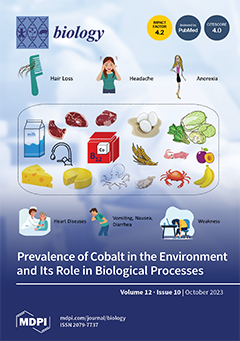This study aimed to investigate
enterococci recovered from eight Portuguese cheeses made with raw ewe’s milk, regarding antibiotic resistance, virulence genes, minimum inhibitory concentration (MIC) of benzalkonium chloride (BAC), biofilm formation capacity, and biofilm eradication (MBEC) by BAC. Antimicrobial resistance against seven antibiotics
[...] Read more.
This study aimed to investigate
enterococci recovered from eight Portuguese cheeses made with raw ewe’s milk, regarding antibiotic resistance, virulence genes, minimum inhibitory concentration (MIC) of benzalkonium chloride (BAC), biofilm formation capacity, and biofilm eradication (MBEC) by BAC. Antimicrobial resistance against seven antibiotics of five groups was evaluated using the disk diffusion method. The presence of the genes that encode resistance to the antibiotics penicillin (
blaZ), erythromycin (
ermA,
ermB, and
ermC), vancomycin (
vanA and
vanB), aminoglycoside (
aac(
6′)
-Ie-aph(
2″)
-Ia), and β-lactam (
pbp5) and the genes that encode virulence factors,
frsB,
cylA,
gelE,
esp, and
agg, were investigated via multiplex PCR. The susceptibility of planktonic cells to BAC was evaluated by the MIC and MBC values of the isolates, using the broth microdilution method. To assess the biofilm-forming ability and resistance of biofilms to BAC, biofilms were produced on stainless steel coupons, followed by exposure to BAC. The results showed a high resistance to the antibiotics vancomycin (87.5%), erythromycin (75%), tetracycline (50%), and penicillin (37.5%). Multidrug resistance was observed in 68.8% of the isolates. Genes encoding the virulence factors FrsB (
frsB) and gelatinase E (
gelE) were detected in all isolates. The
esp and
cylA genes were found in 56.3% and 37.5% of the isolates, respectively. All isolates exhibited a biofilm-forming ability, regardless of incubation time and temperature tested. However, after 72 h at 37 °C,
E. faecium and
E. faecalis biofilms showed significant differences (
p ≤ 0.05). Although most isolates (62.5%) were susceptible to BAC (MIC ≤ 10 mg/L), biofilms of the same isolates were, generally, resistant to the higher concentration of BAC (80 mg/mL) tested. This study using
Enterococcus isolates from a ready-to-eat food, such as cheese, reveals the high percentages of vancomycin resistance and multidrug resistance, associated with the presence of virulence genes, in isolates also capable of producing biofilms resistant to BAC, an important active ingredient of many disinfectants. These results emphasize the need for effective control measures to ensure the safety and quality of dairy products.
Full article






